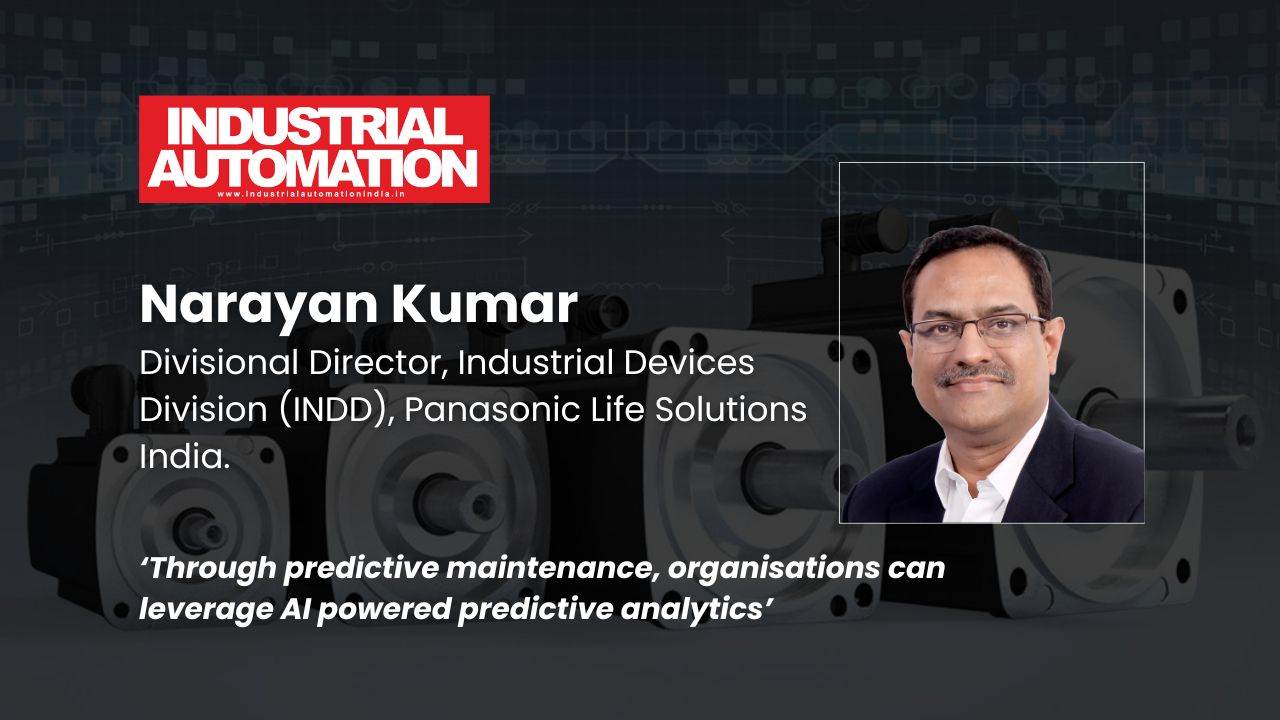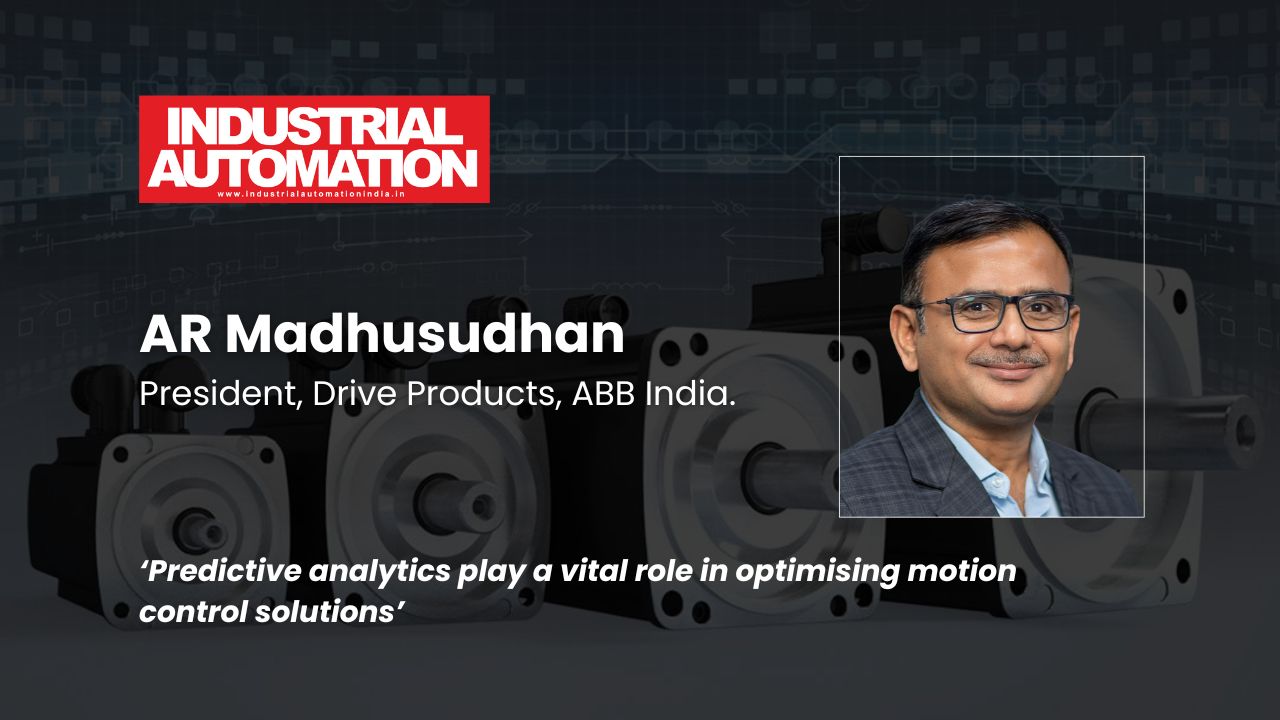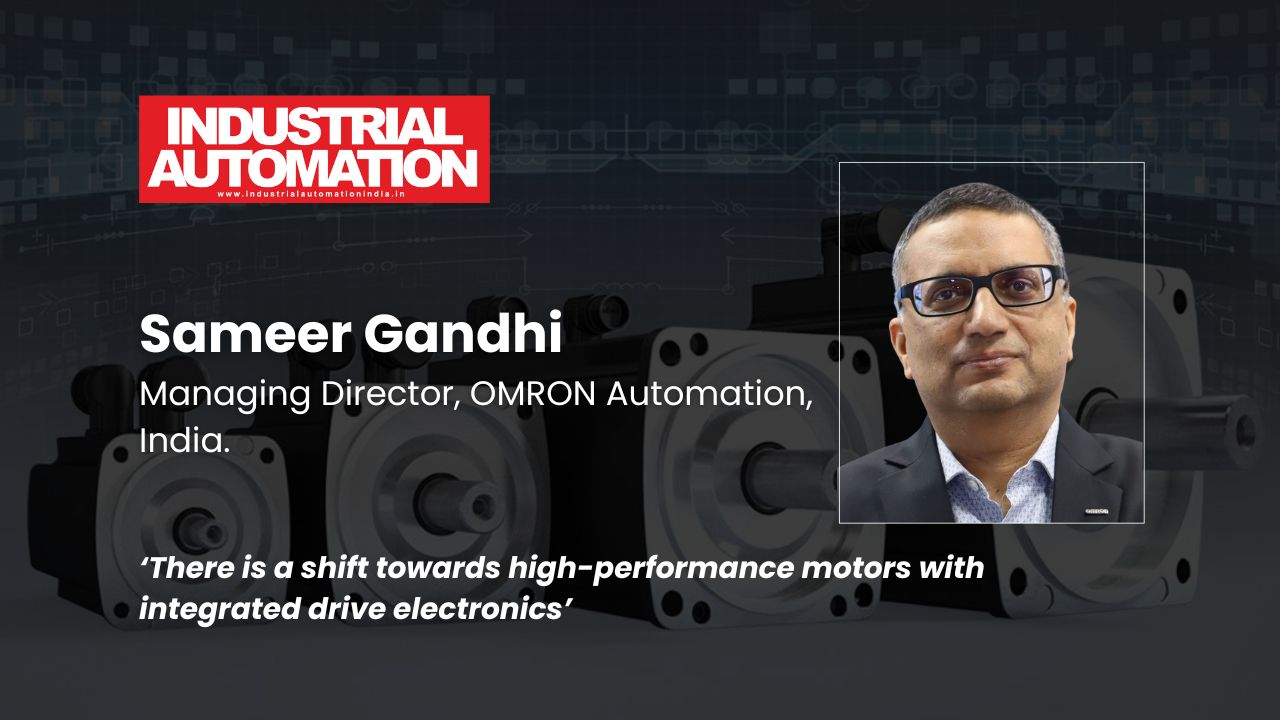Oct 03, 2024
Motion Control in Industry
Experts explore the current trends in motion control technologies, highlighting advancements like IoT integration, AI, and predictive analytics.
![[object Object]](https://admin.industrialautomationindia.in/storage/cover_stories/coverstory-XBIAsJUmlo6uBzZKebJL5gPQGkBNwJCPkPkOmipo.jpg)
Experts debate the present status and emerging trends in the motion control industry.
Accurate positioning of equipment and precise movement of machines is important for optimised production. CNC machines, assembly lines, packaging equipment, medical devices and now, robots – motion control is used in the manufacturing industry for precise movement of machinery and robotic arms. There are several devices and systems that ensure precision in motion control such as various types of servo and stepper motors, linear actuators, encoders, lead screws/ball screws, gearing systems, Delta/Scara robots, different types of sensors, and motion controllers, among others. Every industrial revolution has had its impact on motion control systems and this is an era of digitalisation. What are the latest trends in motion control technologies, particularly in industrial applications?
“Many industrial applications are driven by motors. It may be well-known that drives or variable speed drives (VSD) help control the speed and torque of electric motors, enabling precise control of key processes and machines, across a variety of industries. Additionally, a servo drive paired with servo motors is also known for its precise positioning and speed control,” says AR Madhusudan, President, Drive Products, ABB India. With advancements in technology, these motion control technologies today can be connected to networks and integrated with Internet of Things (IoT) platforms, enabling remote monitoring, data analysis, and predictive maintenance. “To further optimise control, motor-drive systems can be paired with programmable logic controllers (PLCs), which can actively monitor input signals from various sources, including drives,” he adds.

Ajey Phatak, Country Manager Marketing, Beckhoff Automation Pvt Ltd, explains how modern motion controllers use smart and connected systems (Industrial IoT) that use edge computing and IoT integration with smart sensors. “These offer nanometer-level precision, which is essential for industries like semiconductor manufacturing, electronics assembly, and medical devices. High speed controllers with ultra-fast processing speeds are becoming popular, especially in high-speed automation tasks in packaging, textile, and automotive industries,” he elaborates. According to him, integrated motion control and robotics is another trending concept, e.g., use of cobots and integrated motion control systems integrated with multi axes robots.
“The field of motion control technologies is evolving rapidly, especially in industrial applications. One of the remarkable trends is the way Industry 4.0 is transforming motion control systems. For example, the use of the Industrial Internet of Things (IIoT), edge computing, and 5G to enhance predictive maintenance, digital twins, and augmented reality. Also, there is a shift towards high-performance motors with integrated drive electronics or gear elements, offering better efficiency and precision, which are crucial for modern industrial applications,” says Sameer Gandhi, Managing Director, OMRON Automation, India. “Another notable trend is the advent of remote diagnostics and monitoring that facilitates real-time analysis and troubleshooting of motion control systems, minimising downtime and enhancing productivity. There's also a growing focus on safety and compliance, with the development of safer, more reliable components and systems to meet stringent industry standards,” he adds.
While the fact remains that motion control systems have evolved, what are the key differences between traditional motion control systems and modern, digitally-driven systems?

“Traditional systems using analog signals and control are mostly hardware applications offering limited programmability. There is a constant need for manual tuning of motors and demand for high maintenance. More importantly, these systems face challenges with respect to scalability and flexibility which are necessary in the modern industrial ecosystem,” says Narayan Kumar, Divisional Director, Industrial Devices Division (INDD), Panasonic Life Solutions India. “Modern digital driven systems on the other hand use advanced, cutting-edge technologies such as IoT, Industry 4.0, AI, machine learning and smart sensors to name a few, helping industries advance rapidly to an advanced digital operation. Using new-age tech digitally driven systems can be scaled at a very rapid rate, he elaborates.

Upendra Vanarase, Managing Director, Trio Motion Technology India Private Limited, opines that most motion control systems used today in complex industrial applications in packaging, F&B, metal, printing, and pharmaceutical industries are digitally driven. Traditional motion control, according to him, is a thing of the past. “With the need for vertical and horizontal connectivity, machine builders have already moved on to digitally driven motion control, as it offers not only speed, accuracy and precision, but also connectivity with IT systems. With fifth-generation motion control such as Trio’s Motion-First automation solutions, machine builders benefit from lower maintenance, ease of IIoT integrations, higher flexibility in programming, faster and efficient performance, precision with digital feedback and long-term savings,” he explains.
“Traditional motion control systems often relied on analog components and involved extensive wiring, prone to longer downtime, higher maintenance and complex troubleshooting. As we mark a definitive shift to the era of Industry 4.0, digitalisation is already helping industries simplify complex processes at the tap of a smartphone,” says AR Madhusudan. “Much like consumers and business users, industries also are pushing for mobile connectivity and simplicity. Operators can access a drive’s Bluetooth control panel with the tap of a smartphone and make changes without physically accessing sites, including remote locations. For instance, ABB offers ABB Ability™ Mobile Connect for drives – a platform for remote drives support to deliver easy commissioning and troubleshooting via smartphone,” he adds.
What role do emerging technologies, such as Artificial Intelligence (AI) and Machine Learning (MI), play in the development of motion control systems?
According to Ajey Phatak, emerging technologies like AI and ML are playing a transformative role in the development of modern motion control systems. “By leveraging these technologies, motion control is becoming more adaptive, intelligent, and efficient, leading to significant improvements in automation and industrial processes. AI and ML play significant roles in the development of motion control systems,” he observes.
“Firstly, AI and ML facilitate data-driven decision-making by analysing large data volumes, aiding in system design, operation, and maintenance for better performance and efficiency. This leads to enhancement in predictive maintenance by analysing sensor data to predict component failures, thereby reducing downtime and maintenance costs. They also improve performance and precision, with machine learning algorithms optimising control parameters in real-time, adapting to changing conditions, and learning from past performance,” says Sameer Gandhi. AI-driven systems also offer advanced diagnostics and troubleshooting capabilities by analysing data patterns and anomalies to quickly pinpoint issues and suggest corrective actions. This enables adaptive control systems that adjust behavior based on real-time feedback, making them ideal for complex and dynamic environments. “AI is also contributing towards energy efficiency by optimising motor operations to minimise power consumption without compromising performance, leading to significant cost savings. Enhanced safety is another benefit, as machine learning algorithms can detect unsafe conditions and automatically take corrective actions,” he added.
Narayan Kumar draws attention to the fact that new-age technologies help accelerate the digital transformation for enterprises advancing their digital transformation journey at the same time driving the larger Make-in-India agenda too. “For instance, automated tuning enables AI-driven tuning, helping enterprises optimise their system’s performance and further, eliminate manual trial and error. Similarly, through predictive maintenance, organisations can leverage AI powered predictive analytics to detect potential issues thus reducing system downtime. Through real time optimisation technology and machine learning (ML) algorithms can adjust their motion control parameters for energy efficiencies,” he says. Panasonic Industrial Devices Division has recently introduced servo system solutions that leverage some of these advanced technologies to automate the precise tuning process that was once only possible through expert human intervention. MINAS A7 equipped with precAIse TUNING (AI-based automated tuning) offers ultraprecise positioning accuracy through simple initial settings.
One of the trending topics today is energy conservation and concern for the environment, especially the degradation caused by human excesses. How do motion control solutions help promote energy efficiency and sustainability in industrial operations?
“Energy efficiency, sustainability, and security have become integral to factories' requirements of machine builders. The entire machine and the automation solution need to be efficient. Motion components and software programs are the most significant stakeholders in a machine that help machine builders become more efficient and sustainable. Motion control and the program precisely manage machinery's speed, position, and torque, helping reduce unnecessary energy consumption. They also enable real-time monitoring and adjustment of motor functions, ensuring optimal energy consumption. This level of precision minimises idle times, reduces waste, and optimises machine performance,” says Upendra Vanarase. Another area where motion control and the software program work hand-in-hand to support sustainability is the reduction of mechanical wear and tear through smoother operations and better control. Thus, reducing the need for frequent maintenance and part replacements reduces material consumption and waste generation, he opines.

According to AR Madhusudan, motion control solutions like drives that help control the speed and torque of a motor can significantly reduce energy consumption. VSD technology ensures that, rather than running at full speed all the time, motors can be controlled to run at the exact speed required by the process. “In fact, drives can typically decrease energy consumption by up to 25% or more in applications that continually vary the motor’s speed, such as pumps, fans and compressors. Industries can further leverage digitalisation to enhance energy efficiency. As mentioned earlier, modern motor-drive systems include data gathering, networking and control features that enable operators to continuously track real-time information on equipment performance. For example, operators can use data from their drives and motors to identify energy-intensive processes that could be optimised. They can track and identify systems that are least efficient and develop a plan to modernise them,” he elaborates.
Ajey Phatak believes motion control solutions play a vital role in promoting energy efficiency and sustainability in industrial operations. By optimising how machines move and operate, modern motion control systems help reduce energy consumption, minimise waste, and extend equipment life cycles. There are several ways motion control solutions contribute to energy efficiency and sustainability. “Motion control solutions offer a broad array of benefits that support energy efficiency and sustainability in industrial operations. They help industries optimise energy use, reduce waste, and meet environmental targets, ultimately contributing to both cost savings and a reduced environmental footprint,” he emphasises.
What are the common challenges companies face when adopting or upgrading motion control systems? Are there issues of compatibility with different protocols?

“One of the key challenges faced during adoption and upgrading motion control systems is integration with existing systems. It is often difficult, requiring significant customisation and testing to ensure seamless operation. The initial costs can be substantial, covering new hardware, software, and necessary training. There can be supply chain issues too, particularly in sourcing key components like semiconductors, which can lead to delays and increased expenses,” says Sameer Gandhi. Sometimes companies lack the technical expertise needed to implement and maintain these advanced systems, necessitating external support. Maintenance and downtime during upgrades can further impact productivity and add complexity to the process. Compatibility is another challenge. The issues arise from the variety of communication protocols used in motion control systems. “Standardising protocols is a step forward, but ensuring all components, such as controllers, sensors, and actuators, communicate effectively remains challenging,” he explains.
Narayan Kumar agrees with this observation. “Some of the challenges faced by enterprises while adopting or upgrading motion control systems include compatibility issues with different communication protocols (e.g., EtherCAT, Profibus, CANbus), integration with existing hardware and software infrastructure, ensuring real-time performance and synchronisation, and managing data communication and networking. To address these challenges, enterprises should conduct thorough system assessments and feasibility studies to identify potential compatibility issues. Choosing open-architecture systems that support multiple protocols, such as EtherCAT, can enhance flexibility. Implementing a modular design allows for easier integration and upgrades. Finally, a comprehensive migration plan should be developed to minimise disruptions and ensure a smooth transition to the new motion control system,” he explains.
What role does real-time data and predictive analytics play in optimising motion control solutions?
“Predictive data is built on real-time data from various moving parts in machinery. It provides insights into system behaviour, possibly predicting possible system failures due to wear and tear. These insights help in reducing machine downtime and failures. These insights play an essential role when it comes to motion systems. The predictive analysis detects higher vibrations and temperature, suggesting that the bearing or the moving part will likely fail due to its wear,” says Upendra Vanarase. As per him, the motion control systems can use this input to reduce machine speed in order to reduce wear on these areas. “This gives maintenance teams adequate time to execute a planned downtime to replace the worn-out parts. This is just one example of how predictive analysis can be used with motion control to keep the machinery operating without unplanned downtime,” he adds.
AR Madhusudan opines that real-time data and predictive analytics play a vital role in optimising motion control solutions by providing continuous insights that enhance performance, improve energy efficiency, and prevent equipment failures. “ABB's digital solutions, such as ABB Ability™ Condition Monitoring of drives and motors, facilitate this transition from reactive to predictive maintenance. By offering real-time insights into equipment health, these tools help minimise unplanned outages, improve energy efficiency, lower carbon emissions, and extend equipment life. Predictive maintenance ensures maintenance is performed only when needed, reducing costs and enhancing operational reliability,” he states.
“Real-time data and predictive analytics play a crucial role in optimising motion control solutions by enhancing performance, minimising downtime, and improving overall efficiency in industrial operations. These technologies enable systems to monitor conditions in real-time, predict potential issues, and adapt dynamically to changing environments, which leads to better control, resource optimisation, and reduced operational costs,” says Ajey Phatak.
How customisable are modern motion control systems, and how easily can they be adapted to different scales of operation?
“Modern motion control systems have a high degree of customisability and adaptability that makes them suitable for a wide range of applications, ensuring they can meet the specific needs of different industries and scales of operation,” says Sameer Gandhi. According to him, these systems are designed with modular components, allowing for seamless integration of various controllers, actuators, and sensors tailored to specific operational needs. “Advanced software tools further enhance this customisability by enabling precise tuning of motion profiles, control algorithms, and system parameters. They can easily integrate with other automation and control systems, thereby enhancing their functionality within larger production environments. From small-scale applications like 3D printing to large-scale industrial automation, their scalability is a major advantage,” he emphasizes.
Narayan Kumar too concurs that modern motion control systems offer a high degree of customisation to meet the specific needs of various applications. “For instance, modular design allows for easy configuration and scalability, while software-defined motion control mechanisms provide flexibility in adapting to different requirements,” he says. Configurable hardware and scalable architecture enable systems to be tailored to different scales of operation. Regarding scalability, from single-axis control to multiple-axis control, and from low-speed to high-speed applications, these systems can be adapted to a wide range of requirements. Additionally, the flexibility to choose between local and distributed control architectures and cloud-based or edge computing solutions further enhances their adaptability to different operating environments. “At Panasonic Industrial Devices Division, we offer a whole range of industrial solutions that can be customised as per enterprise’s need,” he informs.
“Everyone desires scalability, and machine builders and factories are no different. Without scalability, machine builders will find it extremely hard to adapt to the ever-evolving manufacturing landscape. With scalable motion control systems, machine builders can use the same motion control system with a PLC or a PC. Moreover, this scalability is where Trio introduced the Motion-First approach,” say Upendra Vanarase. With Trio’s Motion-First automation solutions, machine builders in the packaging, food and beverage, metal, pharmaceuticals, printing, and textiles industries benefit from choosing the right motion solution for their machinery. “Machine builders can combine high-speed, multi-axis motion coordination with machine control to achieve seamless and extended device integration. Additionally, machine builders can use one controller for motion, robots and other machine tasks. Moreover, with this approach, machine builders have a single source automation partner for complete solutions, including controllers, servo drives & motors, I/O, HMI, and SCARA robots,” he concludes.
Note: The responses of various experts featured in this story are their personal views and not necessarily of the companies or organisations they represent. The full interviews are hosted online at https://www.iedcommunications.com/interviews)
